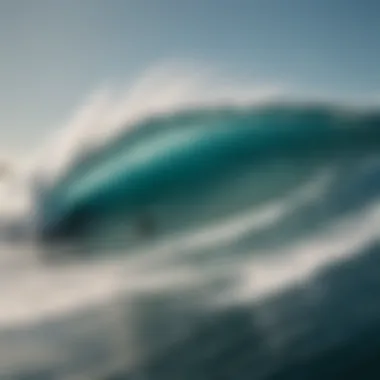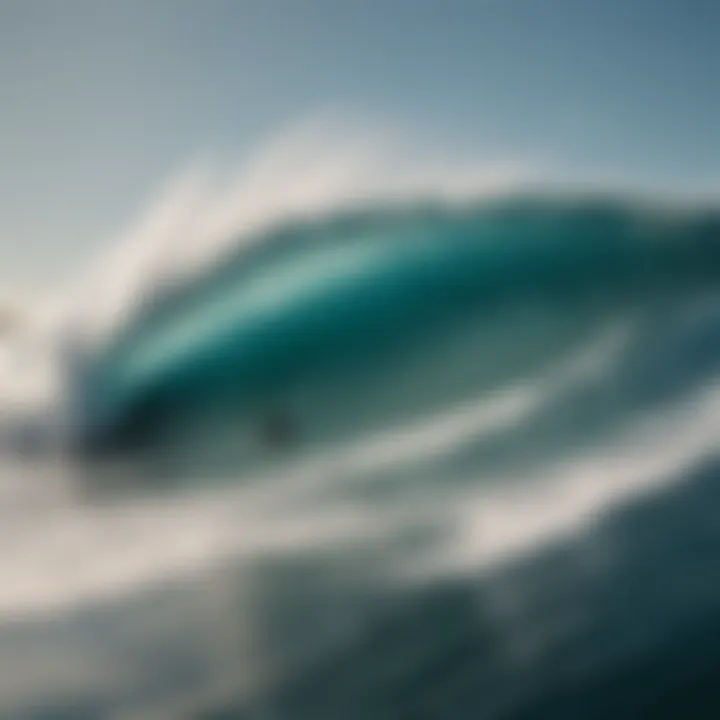Surfing Culture: Techniques, History, and Impact


Intro
Surfing isn’t just about catching a wave; it’s a multifaceted cultural expression that resonates deeply with those who ride the tides. This aquatic sport, which originated in ancient Polynesian societies, has transformed over the decades into a global pastime embraced by millions. The thrill of gliding across the ocean, the camaraderie among surfers, and the sheer beauty of the natural world come together to create an experience that transcends the simple act of surfing.
In this article, we will delve into the heart of surfing culture, examining its historical roots and community aspects, while also addressing the essential techniques and gear that every surfer should be familiar with.
This journey begins with understanding the gear that is as critical to the sport as the waves themselves.
Gear Recommendations
Essential Gear for Beginners
For those just stepping onto a surfboard for the first time, the right gear can make all the difference. The primary items include:
- Surfboard: Choose a soft-top board if you're new. They're more forgiving and less likely to hurt you when you fall.
- Wetsuit: Depending on the water temperature, a wetsuit can keep you warm and comfortable. A thicker suit is necessary for colder waters.
- Leash: This is a cord that attaches your board to your ankle, preventing it from drifting away after a wipeout.
- Wax: Surface preparation is key to maintaining grip on your board. Make sure to apply wax to the top of your surfboard.
Advanced Equipment for Professionals
As surfers progress, their equipment needs evolve too. More experienced surfers may consider:
- Shortboards: These are designed for speed and agility, making them ideal for performing tricks in challenging conditions.
- Fiberglass and Epoxy Boards: Lighter and more durable, these materials offer enhanced performance.
- Performance Wetsuits: Advanced wetsuits are tailored to offer flexibility and reduced drag in the water.
- Surf Traction Pads: For those riding shortboards, these can further improve grip underfoot, enhancing control.
Techniques and Tips
Skill Improvement Strategies
Learning to surf involves more than just trust in the waves; it calls for a study of techniques and styles. Here are a few strategies to improve:
- Practice Pop-Ups on Land: Get comfortable with the motion of popping up by practicing on a flat surface before hitting the water.
- Work on Timing: Timing your entry into the wave is crucial. Observe experienced surfers to understand when to paddle and when to get on your feet.
- Watch Your Body Position: Keep your knees bent and your center of gravity low. This helps maintain balance and stability.
Safety Practices and Guidelines
Surfing carries risks, as does any adventure sport. Keeping safety in mind while enjoying the ocean is imperative:
- Stay Aware of Your Surroundings: Watch for other surfers, rocks, and changing tides.
- Know Your Limits: If the surf looks too challenging, it’s wiser to sit out and observe.
- Respect Local Rules: Every surf spot has its own etiquette – follow it, and be courteous to fellow surfers.
"Surfing is not just a sport; it’s a feeling, a lifestyle, a culture that propels us into the depths of understanding who we are as individuals and as part of a community."
As we explore further into the nuances of the surfing lifestyle, we will take into account the crucial elements like environmental impact and the surf destinations that are considered sacred by many surf enthusiasts. Stay tuned as we ride this wave of insight!
Understanding Surfing
To grasp the essence of surfing, one must delve deep into its history and cultural significance. It's not merely about riding the waves; it's an intricate tapestry woven from community, tradition, and personal expression. Understanding surfing lays the foundation for appreciating the sport, making it crucial for both newcomers and experienced practitioners. The journey on a surfboard is both a physical and spiritual endeavor that connects surfers to the ocean, the environment, and, ultimately, to themselves.
The Origins of Surfing
Surfing's history can be traced back to ancient Polynesian cultures, where it was not just a pastime but a fundamental part of their social and cultural fabric. The earliest accounts of surfing date back to the 12th century in Hawaii, where it was practiced by the royals. The intricacies of board crafting and wave riding were crucial skills, signifying status and mastery over nature. Over time, surfing evolved, spreading across the globe and gaining prominence in various coastal communities.
Each region adapted the practice to its unique environment, showcasing the versatility of surfing. From the cool waters of California to the warm currents of Australia, each locale has its peculiar methods, styles, and traditions. This rich mosaic of surfing highlights not only the adaptability of the sport but also its deep connections to local cultures.
Surfing as a Cultural Phenomenon
Spiritual Connections to the Ocean
For many surfers, the ocean transcends mere recreation. Spirituality plays a profound role in the connection they feel with the sea. This bond is not just about the thrill of catching waves; it’s about embracing the energy, the rhythms, and the mysteries of the ocean. Surfers often describe the feeling of riding a wave as a type of meditation—a moment where time stands still and all worries fade away.
This aspect merits attention because it illustrates how surfing serves as a gateway to mindfulness and relaxation for many. By immersing oneself in the ocean, individuals find a refuge from the chaos of daily life. The practice becomes a form of self-discovery and reflection, aligning perfectly with the increasingly popular movements toward sustainability and eco-awareness.
Surfing in Indigenous Communities
In various indigenous cultures, surfing has deep roots that go beyond just the sport itself. It is tied to their identities, customs, and stewardship of ocean resources. In Hawaii, for instance, surfing is more than a sport; it embodies Aloha, a way of life that emphasizes respect for the ocean and the land. The act of surfing upholds centuries-old traditions and rituals connecting generations to the sea and each other.
The unique feature of surfing in indigenous communities is its role in preserving cultural heritage. It is through these surf practices and rituals that significant values are passed down. Engaging in surfing fosters a communal spirit, allowing for gatherings that emphasize respect for the ocean and the local environment.
This cultural aspect serves not only to celebrate heritage but also to draw attention to contemporary issues like land rights and environmental preservation. As these communities navigate modern challenges, surfing remains an integral part of their fight for identity and sustainability.
"Surfing is the most fun you can have without taking your clothes off." - Matt Warshaw, surfing historian
The Mechanics of Surfing
Understanding the mechanics of surfing is crucial for anyone looking to grasp the essence of this sport. Beyond the thrill of catching waves, the techniques involved play a significant role in safety, skill development, and enjoyment of surfing. A solid grasp on how to read the ocean and effectively ride the waves can elevate a practical enthusiast into a true aficionado. In this section, we'll dive into the foundational elements that pave the way for a successful surfing experience.
Understanding Waves


Wave Formation and Types
When we talk about wave formation and types, we’re really getting into the nitty-gritty of what makes a surfable wave. Waves originate from wind; as gusts whip across the ocean's surface, they transfer energy to the water, creating ripples that grow into waves. Understanding these mechanics helps surfers identify the best conditions to catch waves.
There are key characteristics that classify waves: wind speed, direction, and fetch—all factors that determine how a wave will form. For instance, a wave generated by a distant storm can offer more power compared to a local wind swell. This is why many seasoned surfers often seek waves that have traveled a long distance before breaking, as they are more likely to have energy and structure.
One unique type of wave is the reef break, where waves break over a coral or rocky seabed. These tend to offer faster, more enjoyable rides but come with the added risk of sharp coral. Understanding the nuances of different wave types can greatly influence a surfer’s success and safety.
Weather Patterns Affecting Surf
Weather patterns play an indispensable role in shaping surf conditions. From high-pressure systems that create clean, organized swells to low-pressure systems that churn up chaotic seas, each type of weather system can significantly impact the ride. Surfers must be attuned to these shifts to make informed decisions about when and where to surf.
One crucial aspect here is knowing how to interpret swell reports. Swells can be affected by storms hundreds of miles away, and understanding this correlation allows surfers to forecast potential surf quality days in advance. Popular among surfers is the practice of checking surf forecasts on websites or apps that provide real-time data on waves and wind conditions.
Additionally, seasonal changes can bring about entirely different surfing experiences. For example, winter swells often yield larger waves on the West Coast of the US, while tropical storms can create prime conditions in the summertime in some areas. These variations highlight the complexities of surf and emphasize why it's essential for surfers to become weather savvy.
Fundamental Techniques
Paddling and Positioning
Paddling is perhaps the most underrated skill in surfing. While catching waves is what it’s all about, the ability to paddle effectively can make or break your surf session. A surfer must learn the right positioning on their board to maximize their power in paddling.
Positioning refers to where you are on the board in relation to the water's center of gravity. Too far back, and you’ll miss waves; too far forward, and you risk nose-diving. A balanced position allows you to glide efficiently and conserve energy, ensuring you’re ready when the waves come rolling in. The key is to maintain a streamlined form when paddling, using long, smooth strokes that draw from the core, rather than short, frantic movements.
Timing Your Drop-In
Timing your drop-in is crucial—too early, and you wipe out; too late, and you miss the wave altogether. The art lies in reading the wave’s behavior. After gaining some speed on a wave, a surfer must gauge the moment to shift from paddling to standing.
This timing relies heavily on experience and intuition. Observing other surfers can provide insights into the rhythm of the waves and help you anticipate when to drop. The satisfaction derived from a well-timed drop-in cannot be overstated. It sets the tone for your ride, allowing you to harness the wave's energy for smoother maneuvers and greater success in your session.
"Surfing teaches you to be in harmony with the ocean, to respect its power, and to appreciate the perfect timing for everything in life."
Becoming adept in these fundamental techniques not only improves your surf game but also enhances your overall enjoyment and connection to the ocean.
Essential Equipment
When it comes to surfing, having the right equipment is as crucial as understanding the waves. Essential equipment not only enhances performance but also contributes to safety and comfort, enabling surfers to fully enjoy the experience. From surfboards to wetsuits, each element plays a vital role in the surfing journey, regardless if you're a newbie or a seasoned pro.
Types of Surfboards
Shortboards vs Longboards
The debate of shortboards versus longboards is a classic one in the surfing world. Shortboards are characterized by their sleek design and typically measure between 5 to 7 feet. They are designed for maneuverability, allowing surfers to make sharp turns and execute tricks easily. This makes them hugely popular among advanced surfers seeking high performance in more powerful waves. However, the trade-off here is that shortboards require more skill and balance, making them less forgiving for beginners.
On the flip side, longboards range from 8 to 12 feet in length. They offer greater stability and are great for catching smaller waves, ideal for those just starting out. Many surfers love longboards because they can ride them in a more relaxed manner. The unique feature of longboards is the ability to walk up and down the board while riding, a style that instills a sense of elegance.
Each board type has its own advantages and disadvantages, but the choice ultimately hinges on your personal style and skill level.
Alternative Board Shapes
Beyond shortboards and longboards, there exist alternative board shapes designed for specific styles and conditions. For instance, fish boards are shorter and wider, making them perfect for small, mushy waves. Their wider tail creates great speed and performance, which appeals to surfers looking for fun in less than ideal conditions.
Then we have funboards, bridging the gap between short and longboards. They are around 7 to 8 feet long and have more volume than shortboards, making them easier to paddle. This is a popular fit for those who want the performance of a shortboard but still appreciate the ease of a longboard. Other options also include retro shapes that offer a nostalgic surfing experience.
Each alternative shape tends to serve a particular purpose, which can benefit surfers depending on their preferences and the surfing conditions they encounter.
Choosing the Right Gear
Wetsuits for Different Conditions
Wetsuits are essential to maintaining body temperature in cold waters. They come in various thicknesses, often measured in millimeters, and are designed for different water temperatures. A common choice for warmer climates is a thin shorty, where the body remains insulated yet allows freedom of movement. On the contrary, a thick full wetsuit is better suited for frigid waters, helping to keep surfers warm and agile.
A notable point is that using an inadequate wetsuit can lead to hypothermia, which is something no surfer wants to experience. Therefore, understanding the right wetsuit for the prevailing water conditions is crucial for safety.
Leashes, Wax, and Accessories
Accessories might seem trivial, but they significantly affect your surfing experience. A leash is a safety device that attaches the board to the surfer, preventing it from drifting away when you wipe out. Selecting the right leash length is essential; it should be appropriate for your board size.
Wax is another aspect often overlooked by beginners. It helps to increase traction between the surfer's feet and the board. The type of wax can vary based on water temperature, with colder conditions requiring different wax than warmer environments.
Also, harnassing small accessories like surfboard bags for protection, fins for better control, and sunblock for skin safety contribute to a well-rounded surfing setup.


To sum up, all pieces of equipment serve a specific purpose and understanding this not only enhances the surfing experience, but also ensures you enjoy this sport with the right tools at your disposal.
Surfing Techniques and Styles
Surfing isn't just a physical activity; it is an art form that combines skill, style, and connection with nature. Understanding the various techniques and styles of surfing enhances one's experience on the water, allowing surfers to find their niche and express themselves creatively. Each surfing style carries its own distinctive approaches that cater to varying conditions, skill levels, and personal preferences, making it crucial for both novices and seasoned surfers alike to grasp this subject.
Different Surfing Styles
Shortboarding
Shortboarding is possibly the most recognized surfing style, prized for its agility and dynamic maneuvers. This type typically uses shorter boards ranging from five to six feet long, designed to facilitate quick turns and rapid response. The versatility of shortboards allows surfers to ride smaller waves effectively while still performing complex tricks. The lightweight design of shortboards can be seen as a double-edged sword; while they provide speed and maneuverability, they often require a higher skill level to control effectively. In this article, shortboarding represents the pinnacle for those looking to push their limits, not just in technical skills but also in breaking new ground within the sport.
Longboarding
Contrasting with shortboarding, longboarding is an elegant style characterized by its longer boards, typically measuring over nine feet. Longboards offer a different surfing experience that focuses more on stability and smooth, flowing movements. The style incorporates graceful maneuvers like nose riding, allowing surfers to hang ten (walk to the front of the board) on a wave. Longboarding provides a sense of connection with the water that many surfers find deeply satisfying. While it’s generally seen as more accessible for beginners, longboarding does present challenges, particularly regarding balance and positioning for those aiming to master advanced techniques.
Tow-In Surfing
Tow-in surfing has emerged as a thrilling offshoot of traditional surfing, primarily utilized for tackling massive waves that would be nearly impossible to paddle into. This technique involves a personal watercraft (like a jet ski) towing a surfer into the wave. It dramatically expands the type of waves surfers can ride, opening the door to quintessential big wave surfing spots. The adrenaline rush from this style is unmatched, though it comes with significant risks. Tow-in surfing requires surfers to possess advanced skills and a sound understanding of their limits, along with the ability to handle both the board and the tow equipment safely.
Advanced Maneuvers
Aerials
Aerials remain among the most spectacular maneuvers in surfing, involving a surfer launching off the wave to perform tricks in the air. This technique not only requires great skill, but one also needs to pick the right wave and timing down to the last millisecond. Aerials help to push the boundaries of traditional surfing, showcasing athleticism and creativity. Surfers who master this technique elevate their game and can differentiate themselves in competitions. That said, they often pose risks, including wipeouts, that may lead to injury or equipment damage.
Cutbacks and Off-The-Lips
Cutbacks and off-the-lips are essential maneuvers that emphasize control and precision. A cutback involves turning back towards the breaking wave after riding towards the shoulder, allowing the surfer to stay in the wave’s power zone. This technique is vital for maintaining speed and flow. Off-the-lips, on the other hand, focus on executing quick turns at the lip of the wave, providing a dramatic visual for spectators. Both maneuvers require a strong grasp of wave dynamics and balance, showcasing the blend of artistry and physics in surfing. Surfers who master these will display their proficiency, often resulting in improved performance in competitive settings.
"Surfing is not just a sport; it’s a dance between the ocean and the individual, where styles evolve and flourish uniquely."
Surfing Destinations Around the World
Surfing isn’t just about the waves, it’s about the places that shape the experience. The world is dotted with destinations that offer unique conditions, picturesque landscapes, and rich cultural ties to the sport. The importance of these locations goes beyond just being a spot to catch a few waves; they embody the spirit and lifestyle of surfing. This section aims to provide insight into notable surfing destinations while also considering their respective contributions to the broader surfing culture.
American Surf Spots
California's Iconic Beaches
California stands out as a premier surfing destination and is often the birthplace of many surfing trends. The state has a long coastline, stretching nearly 800 miles, that caters to surfers of all skill levels. Iconic beaches like Huntington Beach and Malibu are crucial in popularizing surfing as a mainstream activity.
One pivotal aspect of California's beaches is their consistent waves, shaped by both natural geography and seasonal swells. Huntington Beach, often referred to as 'Surf City, USA', hosts numerous competitions, attracting surfers from around the globe. The unique feature of California's beaches is the welcoming community that thrives here; seasoned surfers often mentor newcomers, creating a rich culture of learning and camaraderie.
However, these beaches also face significant challenges such as overcrowding and pollution. The environmental concerns linked to urbanization can detract from the natural beauty of the coastline, impacting the overall surf experience. Yet, the vibrant atmosphere and the connected surf community continue to make these beaches a must-visit.
Hawaii's Legendary Breaks
Hawaii is renowned as the cradle of modern surfing. The legendary breaks, such as those on the North Shore of Oahu, carry a mystique that attracts surfers worldwide. Waimea Bay and Pipeline are particularly famous for their powerful waves that can reach heights of over 30 feet, providing thrilling rides for advanced surfers.
A key characteristic of Hawaii's breaks is their cultural significance; surfing is deeply embedded in the local Hawaiian way of life and spirituality. The act of surfing is often viewed as a sacred connection with the ocean, emphasizing respect and responsibility. The rich history combined with the breathtaking scenery makes Hawaii a sublime choice for surfers looking for a unique experience.
However, Hawaii also poses challenges for those who might be unprepared. Strong currents and unpredictable waves require a level of respect and understanding of the local conditions before hitting the water. Those willing to learn and adapt will find themselves richly rewarded by the aloha spirit found in these waters.
International Surfing Hotspots
Bali, Indonesia
Bali is a dream destination for surfers and adventurers alike. It offers a blend of beautiful beaches, vibrant culture, and surf conditions suitable for various skill levels. Kuta Beach is particularly famous among beginners, while more experienced surfers favor spots like Uluwatu and Padang Padang.
The key characteristic of Bali as a surfing destination is its diverse wave options. From gentle swells to challenging reef breaks, it caters to every surfer’s whims. Moreover, the laid-back lifestyle of Bali allows surfers to soak in the surroundings while enjoying surf sessions, creating a perfect balance of exhilaration and relaxation.
Nevertheless, rapid tourism growth in Bali has led to concerns about the environment, such as coastline erosion and waste management. Surfers must be mindful of their impact, making it essential to engage in sustainable practices while enjoying this remarkable locale.
Gold Coast, Australia
The Gold Coast boasts some of the best surf beaches in the world. Famous sites like Snapper Rocks are renowned for their incredible point break, attracting surfers eager for the perfect ride. The warm climate and generally consistent swell patterns make the Gold Coast a favored spot among locals and tourists.
What makes Gold Coast standout is its strong surf culture, illustrated by numerous surf schools and vibrant local competitions. Not only can surfers catch waves, but they can also engage with a community that celebrates the sport and promotes a healthy, active lifestyle.
However, the Gold Coast isn’t immune to challenges. Competition for prime surf spots can lead to crowded beaches. Surfers may need to adjust their expectations and be considerate of others sharing the waves. Despite these small setbacks, the allure of the Gold Coast as a surfing hotspot remains ever-strong for fans of the sport.


Environmental Considerations
The selection of the theme addressing environmental considerations within the surfing culture sheds light on a topic that is not just current but critical. The ramifications of climate change greatly affect how, when, and where surfing can be enjoyed. Understanding these impacts not only helps surfers adapt but also emphasizes the collective responsibility surf communities have in preserving their beloved oceans and waves.
Impact of Climate Change on Surfing
Rising Sea Levels
Rising sea levels represent one of the most palpable consequences of climate change. It poses a serious threat to coastal areas where many surf spots reside. As the oceans swell, some breaks might become submerged, causing well-known surfing areas to vanish over time. This gradual rise could also damage the shoreline infrastructure like parking lots and local shops, essential for surf culture.
Key characteristics of rising sea levels include the potential loss of habitat for marine life, leading to reduced biodiversity, which indirectly affects the quality of surf. This topic is pivotal for the article, as it encompasses how these changes impact not just surfing as a sport but the entire ecosystem that supports it.
The unique feature regarding rising sea levels is the unpredictability; surfers might find their once-favorite spots altered or even erased from the map altogether. It’s a clear disadvantage for those who rely on surf conditions that can be anticipated; changing weather patterns and erosion need to be closely monitored.
Ecosystem Changes
Ecosystem changes are another critical element in the discussion about climate change and surfing. A disruption in the oceanic ecosystem can result from warmer waters, leading to the migration of marine species, affecting local fishing and, consequently, local surf cultures that may depend on them. For instance, if local fish populations decline due to habitat degradation, this could have downstream effects on the overall health of coastal ecosystems.
This subject is vital for the article as it illustrates how the surfing community’s lifestyle is intertwined with environmental health. A hallmark of ecosystem changes is the complexity they introduce to coastal areas, which can lead to adverse effects like algal blooms that impact water clarity, making for less enjoyable surf conditions.
The unique feature of addressing ecosystem changes lies in recognizing the interconnectedness of all life forms. This understanding can help surfers and communities advocate for necessary environmental protections, promoting healthier surf spots for everyone involved.
Sustainable Surfing Practices
Eco-Friendly Equipment
When it comes to surfing mindfully, eco-friendly equipment is a game-changer. Surfers are beginning to recognize that the gear they choose can significantly impact the environment. Many brands now offer boards made from sustainable materials, such as recycled foam and biodegradable resins. This is a popular choice because it aligns with the ideologies of conservation and respect for nature.
The unique feature of investing in eco-friendly equipment is the tangible reduction of one’s carbon footprint, benefitting the environment while maintaining surfing traditions. Having options that do not compromise performance means surfers do not need to sacrifice their love for the sport for their eco-consciousness.
Community and Surfing Culture
The essence of surfing goes much deeper than just riding waves; it's intertwined with community and a shared culture that shapes identities and lifestyles. From local hangouts to global gatherings, surfing communities play a pivotal role in nurturing the sport and its practitioners. Beyond the thrill of carving through the ocean, surfers find camaraderie, shared passion, and mutual respect, instilling a sense of belonging amidst diverse backgrounds.
The Surfing Lifestyle
Living the surfing lifestyle often means embracing values like freedom, adventure, and an intrinsic respect for nature. Surfers typically prioritize spiritual connections with the ocean, nurtured through seamless hours spent catching waves. Surfers usually value simplicity, opting for minimalist living that allows for spontaneity and exploration.
This lifestyle transcends just riding a board; it influences daily routines, fashion choices, and social connections. Many surfers decorate their homes and personal spaces with surf memorabilia, not only as a badge of honor but as a way to convey their deep-rooted passion.
Notably, the surf culture carries its own lingo, often adopted by locals, which strengthens the ties within the community. Terms like ‘sick’ (to describe an impressive wave) or ‘gnarly’ (for challenging conditions) reflect an exclusive language that connects enthusiasts.
Competitions and Events
World Surf League
The World Surf League, or WSL, stands out as the pinnacle of professional surfing competitions. It gathers the world's best surfers and showcases their skills in thrilling arenas. This organization plays a fundamental role in elevating surfing into a sport recognized worldwide, with competitions viewed in homes globally.
A key characteristic of the WSL is its structured format, consisting of specified events throughout the year. Athletes compete for rankings and titles, thus boosting the professional appeal of the sport. This, in turn, encourages young surfers to aspire to professional heights—igniting hopes and ambitions shaped by legendary names who dominate the league.
Though immensely powerful in promoting surfing, the WSL also has disadvantages, such as its commercial nature sometimes overshadowing grassroots competitions. The pressure to perform at the highest level can also detract from the sport's original recreational spirit.
Local Competitions
Local competitions often serve as the lifeblood of surfing communities. These events bring families, friends, and spectators together, amplifying local pride and enthusiasm for the sport. Participants ranging from beginners to advanced surfers can showcase their skills and compete in a supportive environment.
One standout feature of local competitions is their accessibility—anyone can join, regardless of experience. This inclusivity cultivates a welcoming atmosphere. Unlike the high-stakes nature of professional leagues, these local events prioritize fun and community bonding.
However, a potential drawback exists; in smaller competitions, the absence of substantial sponsorship and media attention may limit opportunities for surfers to gain visibility or advance further in their careers.
Building a Surf Community
Local Surf Schools
Local surf schools play an essential part in building and fostering surf communities. They provide introductory lessons, training aspiring surfers and often serve as the first step for many to discover their passion for riding waves. These schools can build skills and, just as importantly, cultivate friendships among participants.
A defining aspect of these local surf schools is their connection to the environment, incorporating lessons about ocean safety and environmental stewardship. By raising awareness around ocean health, they contribute to a responsible surfing culture. As community-centric institutions, local surf schools often participate in beach clean-ups and eco-friendly initiatives, fostering a sense of shared responsibility.
Yet, the selection of local surf schools can vary in quality, resulting in inconsistent experiences for students, depending on the instructors’ expertise or school facilities.
Online Communities and Forums
In the digital age, online communities and forums have emerged as valuable extensions of the surf culture. Platforms like Reddit and specialized Facebook groups serve as vibrant spaces where surfers from all levels exchange tips, share experiences, and discuss the latest trends in gear or technique. These virtual circles foster knowledge sharing without the constraints of geographic barriers.
The key characteristic of these online platforms is inclusivity; regardless of skill level, anyone can join in the conversation. For many, it creates a safe haven to ask questions and receive feedback from seasoned surfers. The sense of community can be felt through collective discussions around shared challenges, tips for improvement, or even anecdotal stories from the sea.
However, one must approach online information critically. Due to varying levels of expertise, some suggestions may lack accuracy or applicability to individual situations.
Ultimately, the fusion of local, competitive, and online elements builds a complex tapestry of surfing culture, enriching the sport while adapting to the ever-changing tides of society.















